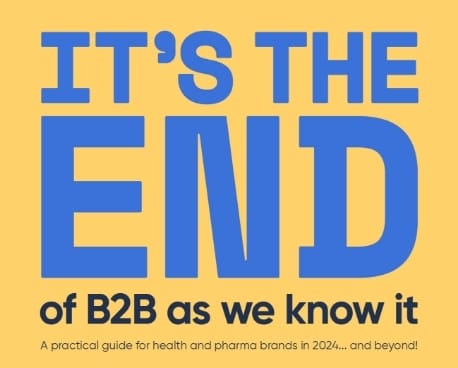Having trouble recruiting patients for clinical trials?
Recruiting patients for clinical trials can be one of the most challenging and time-consuming stages of medical product or service development. Research shows that a poor recruitment plan can cause significant delays, result in small study sizes and even lead to early termination.
There are many strategies that can make it easier, but your primary focus should be on the patient’s needs and perspective.
You want to meet patients where they already are on their health journey. This means taking a multi-channel approach, using not only traditional advertising but also social media marketing, partnerships with healthcare professionals and detailed search engine optimisation.
In this blog post, we look at how to construct an effective patient acquisition plan for clinical trials.
What’s new in the world of clinical trial recruitment in 2023?
The two biggest updates we’ve seen over the past 12 months have been a change in efficacy for one of the top ad platforms due to a targeting update, and the opportunity for a change in approach brought about by an increase in popularity for decentralised clinical trials (DCTs).
The gradual decline of Facebook
Facebook has historically been a key driver for patient recruitment but last year they removed targeting for topics that people may perceive as sensitive, this has led to a slight decline in the efficacy of the platform for recruitment. Thankfully we have always advocated a multi-channel approach to getting in front of any audience, so our solution was to divert some additional spend from Meta ads to social platforms such as Reddit and TikTok.
In 2023 we have also been seeing success with broadcast ads and sponsorships on Podcast networks. The key takeaway here is never to become too reliant on one ad platform.
The rise of decentralised clinical trials
The increasing prevalence of DCTs have allowed us to expand the geographic targeting for clinical trial recruitment campaigns, which calls for a brand new approach. Widening the pool of candidates, as well as the reduced friction for patient participation, has vastly brought down the average cost per acquisition for our average campaign. This means that we’re able to generate the same, excellent, results on a much smaller budget over the last 12 months.
What is clinical trial recruitment?
Clinical trial recruitment is when medical researchers reach out to potential patients to try novel treatments, including new drugs and therapies. By this point in a treatment’s development, it has already passed the necessary safety tests for human trials.
Patient recruitment is crucial for a clinical trial’s success because it shows regulators that a new product is both safe and effective for a wider population.
Recruitment for clinical trials may be limited in scope – for example, a new chemotherapy drug might only need testing on people with a specific type of breast cancer – or might be open to large parts of the population. Usually, the higher the number of participants, the more meaningful the results of the trial will be.
Recruitment for ‘healthy patients’ to test population-wide drugs, like vaccines, will also look different to recruitment for patients with a particular illness. Recruiting ‘healthy patients’ may require more incentives and outreach, as this group won’t be actively looking for new treatments, however, audience sizes are potentially much larger and easier to target than niche demographics of patients who may be suffering from chronic illnesses.

Patient recruitment: What are the challenges of recruiting patients for trials?
Studies show that as many as 86% of trials fail to meet their recruitment quota on time. This not only delays getting the product to the healthcare market but can also lead to inconclusive results. The challenges of recruiting patients include:
Lack of realistic goals
In some cases, clinical trials are pegged to funding and a rigid schedule. Researchers may underestimate how long patient recruitment will take and overestimate how many people their team can reach. For instance, in the US, patient recruitment has been shown to take roughly 30% of trial time – that’s longer than any other step.
Patient interest vs patient suitability
Even if 1000 people initially express interest in the trial, researchers must ensure that those people are suitable to take part. Typical restrictions include not only a person’s age and gender but also whether they are on other medications or have additional health conditions.
Patient refusal
Patients may initially be unaware of the commitments necessary to take part, and may later refuse to continue participating. Some common reasons for patient refusal include:
- Insufficient compensation
- Travel time or difficulties
- Scheduling conflicts (e.g., only able to do weekends due to work or family commitments)
- Concerns about risks
- Tests are too time-consuming
Read on to explore solutions for these common problems.
Tips for recruiting the right patients for trials
There are many patient recruitment strategies you can use to make sure your clinical trial is a success.
Set proactive and realistic goals
Be generous with the recruitment time from the outset and set a realistic timeframe – this can save the trial from failing to meet the promises made in the original schedule.
When setting a minimum enrollment number, ensure that the initial recruitment number is at least double this to ensure that the enrollment threshold is met. Start planning for patient recruitment as soon as possible during the trial and anticipate delays as an inevitable part of managing tens if not hundreds of people.
Partner up with local healthcare professionals
Research shows that patients are more likely to trust information that comes from their doctor or a non-profit, rather than from advertising. Clinicians and other healthcare professionals can already know their medical history, so they can act as the first step in the filtering process when it comes to patient suitability.
Marketing materials for healthcare settings can include printed leaflets and signs, ad space on a website and direct email marketing for clinicians.
Leverage social media platforms
Social media marketing can be a particularly effective approach for recruiting ‘healthy patients’. Younger people spend more time on social media platforms like Instagram and Twitter, where you can use paid advertisements to inform them of trial recruitment.
Young people, including students, are often a target demographic for ‘healthy patients’ or control groups because they tend to have fewer existing health conditions, may be interested in the compensation and may have a more flexible schedule than adults with work and family care commitments.

Prioritise accuracy and patient-friendly language
When we create content for patient acquisition, we liaise directly with clinicians and researchers to ensure that the marketing is accurate and in keeping with medical advertising guidelines, such as those stipulated by the GMC. Patients should know exactly what the clinical trial entails, without any changes along the way.
A helpful patient acquisition plan will be accessible, empathetic and informative. You can build patient trust by anticipating their most pressing questions beforehand. A FAQ page might include practical information, like how much of their time you need, as well as detailed instructions on who is suitable for the trial. Can they be of any age or sex? Will they be able to take common medicines during the trial, such as pain relief, antiarrhythmics or contraceptive pills?
Being clear and explicit in your advertising will also prevent wasting your time and budget engaging with people who aren’t suitable for the trial.
Ethnic minorities may have a higher lack of trust in clinical research due to historically unethical studies and negative healthcare experiences, but research shows they are more likely to participate in low-risk, observational studies. Recruit with this in mind and answer patients’ concerns promptly and with empathy.
Health literacy is often lower in minority communities, with less knowledge about how clinical trials work. Being clear, accurate and upfront in all of your marketing material is essential for putting potential participants at ease.
Compensate fairly
Common reasons for patient refusal tend to relate to time and money constraints. Solutions to these problems include:
- Arranging or paying for transportation
- Providing meal vouchers or meals during study visits (make sure to cater to dietary restrictions)
- Including evening and weekend hours as possible study visit hours
- Considering on-site or nearby childcare
Consider how patients search
Patients unsatisfied with their current treatment options can sometimes look for new solutions or clinical trials on their own, which saves you valuable outreach time and money.
They may research their condition, its symptoms and medication side effects. Understanding their search journey means you can provide answers and clinical trial information. They may also research your previous clinical trials – making information on your previous trials easy to find helps them build trust.
Search engine optimisation (SEO) best practices are always changing, so make sure you stay up to date on the most relevant metadata and keyword strategies – a specialist medical marketing team can help here.

Understand and comply with health advertising regulations
Even products under development are subject to complex healthcare advertising regulations. We can help you navigate:
- Advertising prescription medications, particularly when the side effects are yet to be established by the trial
- Handling GMC and GDPR data, which you will need to collect on prospective participants and dispose of correctly in an agreed time
- Maintaining website accessibility to ensure your information is available and useful to everyone
- Experimental and speculative medicine regulations, including those for supplements and herbal remedies
Track refusals
Ensure you have an open-ended survey for patients to fill out if they refuse to take part in the trial at any stage of recruitment. Then make sure you act on your findings – if most patients drop out because of the cost of travel, consider remote options or whether there is room in your budget to reimburse ticket costs. In many cases, the cost of accommodating the patients is less than having to re-recruit.
In summary
Clinical trial recruitment is changing in the digital age, which comes with both challenges and opportunities. The best strategy is to always put the patient first and anticipate their needs to keep them engaged and onboard with the trial.
With a wealth of data on how patients are interacting with new opportunities in health, we can ‘meet them where they are’ – whether that is through clinician partnerships, social media marketing or SEO.
Taking a proactive approach to patient enrollment by planning your recruitment strategy early can prevent many headaches later on. Our team can help you formulate the best plan for your trial, factoring in our insights from patient data and expertise in healthcare marketing.
Sources
- https://trialfacts.com/patient-recruitment-timelines-why-they-should-be-important-to-you/
- https://www.antidote.me/hubfs/docs/whitepapers/Antidote%20Whitepaper%20-%20Patients%20Have%20a%20Type.pdf
- https://repository.upenn.edu/cgi/viewcontent.cgi?article=1004&context=crp#:~:text=Patient%20recruitment%20is%20a%20key,failing%20to%20improve%20
- https://www.researchamerica.org/news-events/news/lack-trust-less-barrier-clinical-trial-participation-according-minority-populations








